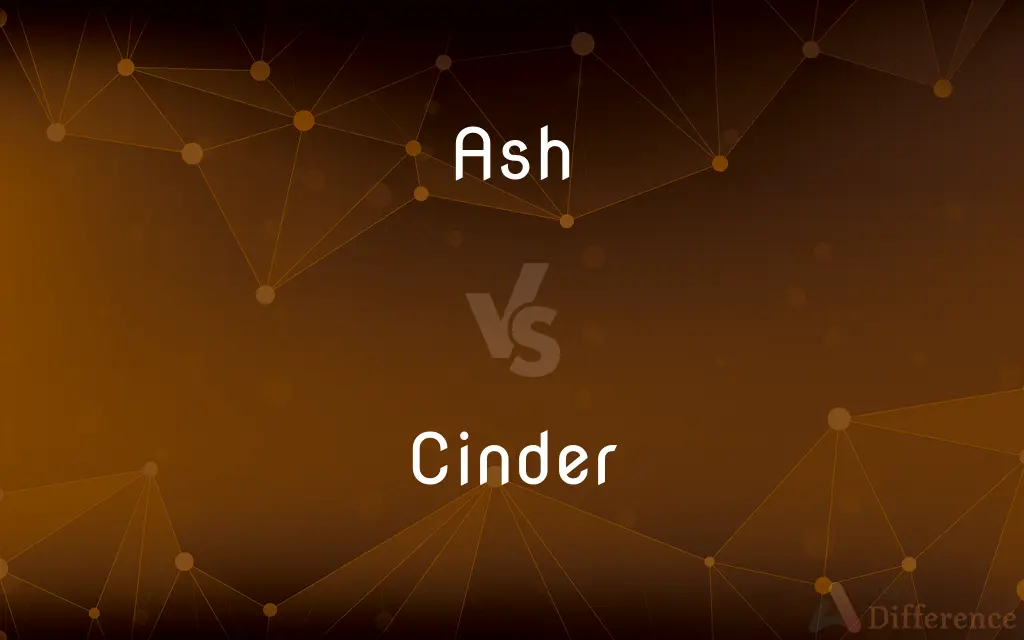Ash vs. Cinder — What's the Difference?
By Fiza Rafique & Urooj Arif — Updated on April 5, 2024
Ash results from burned organic matter, retaining some unburnt carbon and nutrients, whereas cinder comes from volcanic or industrial combustion, being porous and often used in construction.

Difference Between Ash and Cinder
Table of Contents
ADVERTISEMENT
Key Differences
Ash is the powdery residue left after the burning of wood, paper, or other organic materials, characterized by its fine texture and grayish color. It often contains a mix of unburnt carbon and minerals beneficial to soil. On the other hand, cinder refers to the lightweight, porous pieces of material, usually produced by volcanic activity or the burning of coal and other industrial processes. Cinder's composition and uses differ significantly from ash, highlighting its versatility in construction and landscaping.
While ash is commonly associated with its use as a soil amendment, enriching the soil with nutrients and helping to adjust pH levels, cinder is not typically used for such purposes. Instead, cinders are often utilized in the construction of lightweight concrete blocks and as a drainage layer in landscaping projects. The difference in application underscores the distinct properties of each material, with ash benefiting agricultural practices and cinder supporting construction.
Ash can sometimes contain harmful substances depending on what was burned to produce it, requiring careful handling or disposal to avoid environmental or health risks. Conversely, cinder, especially when coming from volcanic sources, is usually inert, posing less risk of contamination but still requiring proper handling due to its abrasive nature and potential for creating airborne particles.
In the context of gardening, ash is valued for its potassium content and its ability to deter pests when used as a powder on plant leaves. Cinder, however, is prized for its ability to retain moisture when used as a mulch or in potting mixtures, providing aeration and improving soil structure without the nutrient contribution found in ash.
The historical and cultural significance of ash as a symbol of renewal and cleansing in various traditions contrasts with cinder's association with destruction and rebuilding, especially in areas affected by volcanic eruptions. This symbolic difference mirrors the physical contrasts between the two substances, further distinguishing their roles and perceptions in society.
ADVERTISEMENT
Comparison Chart
Source
Burning of organic materials
Volcanic activity or industrial combustion
Texture
Fine, powdery
Porous, lightweight
Uses
Soil amendment, pest control
Construction material, drainage in landscaping
Risk
Potential for harmful substances
Generally inert, abrasive
Cultural Significance
Symbol of renewal
Associated with destruction and rebuilding
Compare with Definitions
Ash
A symbol of mourning or repentance in various cultures.
She wore ash on her forehead to mark the beginning of Lent.
Cinder
Waste material from industrial combustion.
The factory's operations produced a significant amount of cinder.
Ash
A light gray color reminiscent of ash.
The walls were painted an elegant shade of ash.
Cinder
Material used in construction, especially in lightweight concrete blocks.
The building's foundation used cinder blocks for added stability.
Ash
Mineral residues beneficial to soil health.
He spread fireplace ash in the garden as a natural fertilizer.
Cinder
A small piece of partly burned coal or wood.
Cinders from the campfire flew into the night sky.
Ash
The powdery residue left after the burning of organic materials.
The fireplace was full of wood ash from last night's fire.
Cinder
Volcanic rock fragments.
The ground was covered in black cinder after the eruption.
Ash
The remains of human bodies after cremation.
The family scattered his ashes across the lake.
Cinder
A symbol of destruction or rebirth.
The artist used cinder in his work to represent the city's rebirth from ruins.
Ash
An Old English runic letter, ᚫ, a vowel intermediate between a and e. It is represented in the Roman alphabet by the symbol æ or Æ.
Cinder
A cinder is a pyroclastic material. Cinders are extrusive igneous rocks; they are fragments of solidified lava.
Ash
Ash or ashes are the solid remnants of fires. Specifically, ash refers to all non-aqueous, non-gaseous residues that remain after something burns.
Cinder
A small piece of partly burnt coal or wood that has stopped giving off flames but still has combustible matter in it
A cold hearth full of cinders
Ash
The powdery residue left after the burning of a substance
I turned over the ashes
Cigarette ash
Cinder
Waste matter produced by smelting or refining ore; slag.
Ash
A trophy for the winner of a series of Test matches in a cricket season between England and Australia.
Cinder
A small piece of burned or partly burned substance, such as coal, that is not reduced to ashes but is incapable of further combustion.
Ash
A tree with compound leaves, winged fruits, and hard pale timber, widely distributed throughout north temperate regions.
Cinder
A piece of charred substance that can burn further but without flame.
Ash
The grayish-white to black powdery residue left when something is burned.
Cinder
Cinders Ashes.
Ash
(Geology) Pulverized particulate matter ejected by volcanic eruption.
Cinder
Cinders(Geology) See scoria.
Ash
The mineral residue of incinerated organic matter, used as an additive in pet foods.
Cinder
(Metallurgy) See scoria.
Ash
Ashes Ruins
The ashes of a lost culture.
Cinder
Slag from a metal furnace.
Ash
Ashes Bodily remains, especially after cremation or decay.
Cinder
To burn or reduce to cinders.
Ash
Any of various chiefly deciduous trees of the genus Fraxinus, having opposite, pinnately compound leaves, clusters of small flowers, and one-seeded winged fruits.
Cinder
Partially or mostly burnt material that results from incomplete combustion of coal or wood etc.
Ash
The strong, elastic wood of any of these trees, used for furniture, tool handles, and sporting goods such as baseball bats.
Cinder
An ember.
Ash
(Linguistics) The letter æ in Old English and some modern phonetic alphabets, representing the vowel sound of Modern English ash.
Cinder
Slag from a metal furnace.
Ash
To reduce or convert to ash
Ash a tissue sample for analysis.
Cinder
Any strong stimulant added to tea, soda water, etc.
Ash
(Informal) To drop ashes from a cigar or cigarette
Accidentally ashed on his own sleeve.
Cinder
(transitive) To reduce to cinders.
Ash
The solid remains of a fire.
The audience was more captivated by the growing ash at the end of his cigarette than by his words.
Ash from a fireplace can restore minerals to your garden's soil.
Ashes from the fire floated over the street.
Ash from the fire floated over the street.
Cinder
(transitive) To cover with cinders.
We plan to cinder this path.
Ash
(chemistry) The nonaqueous remains of a material subjected to any complete oxidation process.
Cinder
Partly burned or vitrified coal, or other combustible, in which fire is extinct.
Ash
Fine particles from a volcano, volcanic ash.
Cinder
A hot coal without flame; an ember.
Ash
(in the plural) Human (or animal) remains after cremation.
The urn containing his ashes was eventually removed to a closet.
Cinder
A scale thrown off in forging metal.
Ash
Mortal remains in general.
Napoleon's ashes are not yet extinguished, and we're breathing in their sparks.
Cinder
The slag of a furnace, or scoriaceous lava from a volcano.
Ash
(figuratively) What remains after a catastrophe.
Cinder
A fragment of incombustible matter left after a wood or coal or charcoal fire
Ash
A gray colour, like that of ash.
Ash
A shade tree of the genus Fraxinus.
The ash trees are dying off due to emerald ash borer.
The woods planted in ash will see a different mix of species.
Ash
(uncountable) The wood of this tree.
Ash
The traditional name for the ae ligature (æ), as used in Old English.
Ash
(chemistry) To reduce to a residue of ash. See ashing.
Ash
(intransitive) To hit the end off of a burning cigar or cigarette.
Ash
(transitive) To hit the end off (a burning cigar or cigarette).
Ash
To cover newly-sown fields of crops with ashes.
Ash
A genus of trees of the Olive family, having opposite pinnate leaves, many of the species furnishing valuable timber, as the European ash (Fraxinus excelsior) and the white ash (Fraxinus Americana).
Ash
The tough, elastic wood of the ash tree.
Ash
Sing. of Ashes.
Ash
To strew or sprinkle with ashes.
Ash
The residue that remains when something is burned
Ash
Any of various deciduous pinnate-leaved ornamental or timber trees of the genus Fraxinus
Ash
Strong elastic wood of any of various ash trees; used for furniture and tool handles and sporting goods such as baseball bats
Ash
Convert into ashes
Common Curiosities
What are the uses of cinder in construction?
Cinder is used in the manufacture of lightweight concrete blocks and as a drainage layer in landscaping due to its porous nature.
Can ash be used in gardens?
Yes, ash can be used as a soil amendment to add nutrients and adjust pH levels, but it should be used carefully due to potential contaminants.
What is the difference between ash and cinder in terms of texture?
Ash is fine and powdery, while cinder is porous and lightweight, reflecting their different origins and compositions.
What precautions should be taken when using ash in gardening?
Ash from treated wood or synthetic materials should be avoided due to potential toxins, and its application should be limited to maintain soil balance.
Can cinder be used for soil improvement?
While not typically used for nutrient contribution, cinder can improve soil structure by enhancing drainage and aeration.
What is ash made of?
Ash is composed of fine particles left after the complete or partial burning of organic materials, including unburnt carbon and mineral nutrients.
How is cinder produced?
Cinder is produced through volcanic activity or the industrial combustion of coal and other materials, resulting in porous, lightweight fragments.
Is ash harmful to humans?
Ash can contain harmful substances, especially if it results from the burning of treated or synthetic materials, necessitating careful handling.
Why is cinder preferred in certain types of construction?
Its lightweight and porous nature makes cinder ideal for creating insulating concrete blocks and in landscaping for moisture retention and drainage.
Are cinders safe for the environment?
Cinders, particularly from volcanic sources, are generally inert and pose less environmental risk, though industrial cinders may contain harmful substances.
How do ash and cinder differ in their environmental impact?
Ash's potential for toxic residue contrasts with cinder's general inertness, though both require proper management to minimize environmental effects.
What symbolic meanings do ash and cinder carry?
Ash symbolizes renewal and cleansing, whereas cinder is associated with destruction and the potential for rebuilding.
Is there a cultural significance to the use of cinder?
Cinder, especially from volcanic eruptions, can symbolize both the destructive force of nature and the potential for new beginnings.
Can ash be hazardous if inhaled?
Yes, inhaling ash, especially from synthetic materials, can be harmful, highlighting the need for protective measures during cleanup or use.
How should cinder be handled in construction to ensure safety?
Proper handling includes wearing protective gear to avoid inhalation or skin irritation from the abrasive particles.
Share Your Discovery

Previous Comparison
Feel vs. Realize
Next Comparison
Chisel vs. GougeAuthor Spotlight
Written by
Fiza RafiqueFiza Rafique is a skilled content writer at AskDifference.com, where she meticulously refines and enhances written pieces. Drawing from her vast editorial expertise, Fiza ensures clarity, accuracy, and precision in every article. Passionate about language, she continually seeks to elevate the quality of content for readers worldwide.
Co-written by
Urooj ArifUrooj is a skilled content writer at Ask Difference, known for her exceptional ability to simplify complex topics into engaging and informative content. With a passion for research and a flair for clear, concise writing, she consistently delivers articles that resonate with our diverse audience.
















































